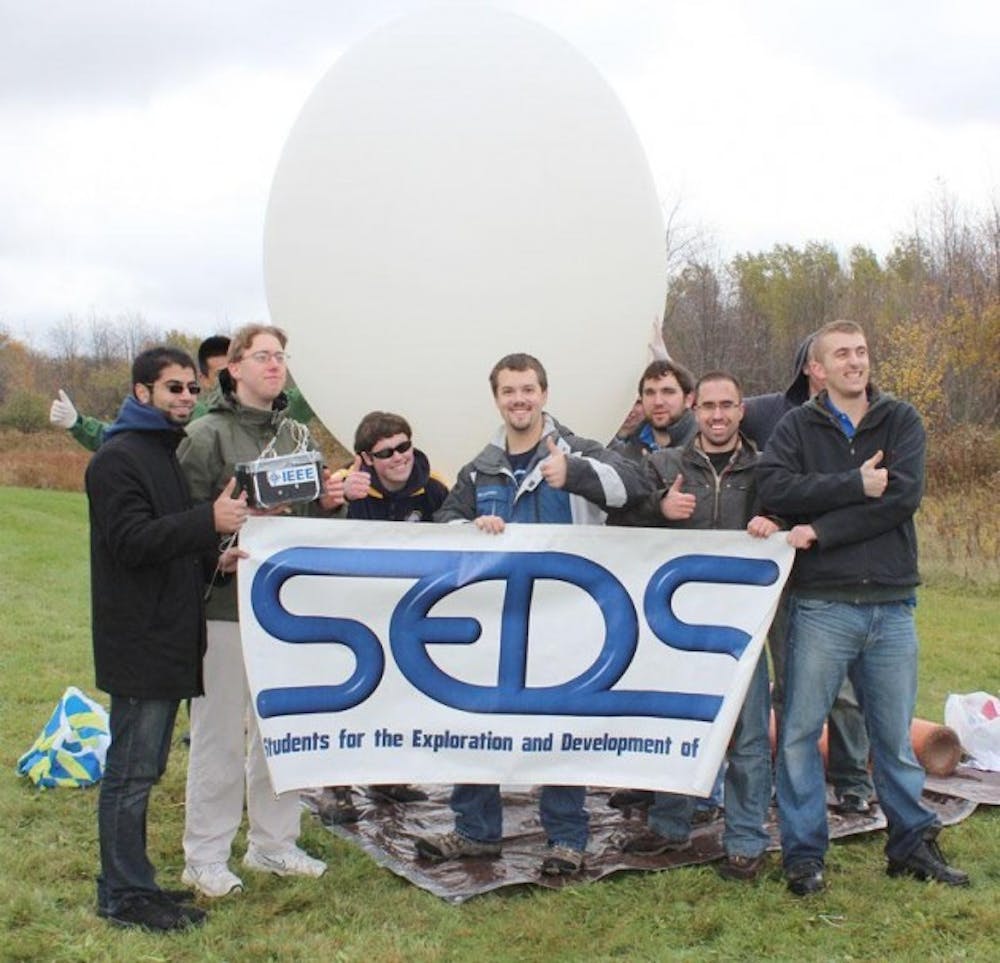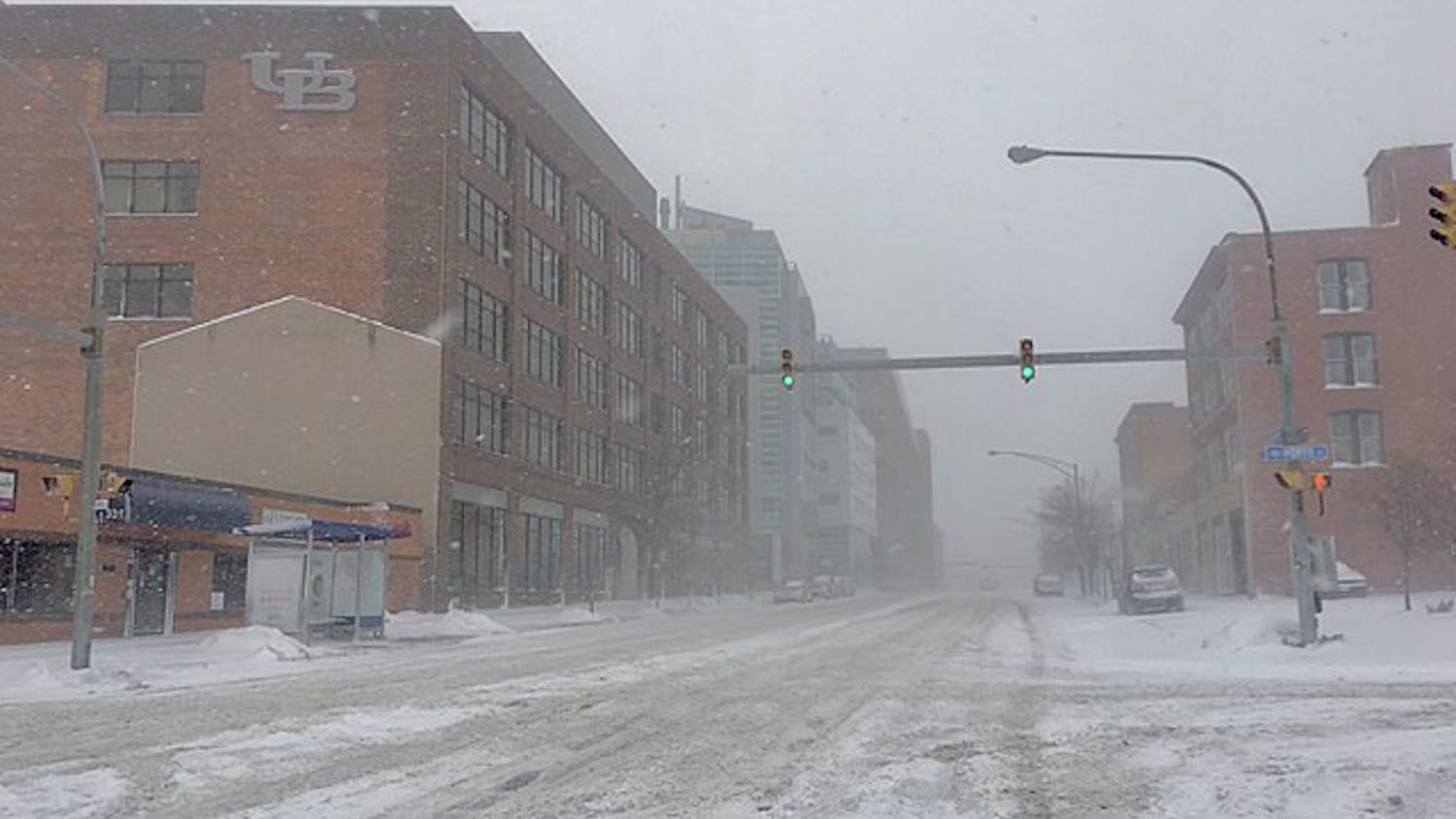It's a bird. It's a plane. It's a…weather balloon?
While many students spend their weekends partying, studying, and hanging out with their friends, one club at UB spent its weekend studying the outer realms of Earth's atmosphere.
UB Students for the Exploration and Development Space (UB-SEDS) is a club that sets its ambitions skyward to generate interest and activism in the community for any and all space-related topics, according to Sean Lyons, a senior aerospace engineering major.
Lyons was the project manager of the club's High-Altitude Weather Balloon Project (HAWB). The project's goal was to send a weather balloon into the sky to measure temperature and atmospheric pressure. In addition, the team wanted to capture pictures and video footage to document the trip and measure the atmospheric boundary layers.
"This project is one of the most challenging yet rewarding feats of my undergraduate career," Lyons said. "The lessons I have learned and [the] success of this project have given me an inspiration no course offered at this university could ever provide."
The launching of the balloon last Saturday, Oct. 22, was the culmination of many hours of planning. The group had to not only raise the funds to take on this project, but it also had to develop the means by which to perform all the desirable functions.UB-SEDS procured $1,100 in funding from sponsorships from local companies and from Sub Board I Inc.
"The idea for this came about in either October or November of last year, when we saw a video of a father-and-son team that sent an iPhone aboard a balloon and recovered it, becoming a temporary media sensation on many newscasts and newspapers," said Andrew Dianetti, president of UB-SEDS and a junior aerospace engineering major. "Other schools and groups throughout the country have developed such payloads as well, but nobody in this area had attempted it, as far as we could find."
One of the biggest challenges for the group was finding a way to develop a means by which to have enough propulsion to lift the equipment, called ‘the payload,' into the air, according to Lyons.
"The propulsion was a meteorological weather balloon, attached to our scientific payload, with a parachute between the two, all attached by high strength Kevlar rope," Lyons said. "The balloon, filled with Helium, ascends to its peak altitude and bursts. The parachute then gradually becomes more effective due to increasing air density and drag force from its low magnitude at maximum altitude."
Another important aspect of the project was to have a way to track the location of the balloon; this task proved to be no small feat. The group utilized a high-altitude GPS transmission system in conjunction with a HAM radio frequency to follow the balloon along its flight path. As the balloon rose, the transmissions were picked up by other receivers and logged via Google APRS, an application that maps data using radio frequency.
The balloon traveled over 91 miles from its launching point in Holland, NY to its eventual recovery location in Sodus Bay, NY, outside of Rochester, NY. During a three-hour flight period, the balloon rose to a height of over 95,000 feet before the balloon popped due to the decreasing air pressure. The payload started its descent towards Earth at over 90 miles per hour before the parachute engaged and safely guided the payload to the ground in one piece.
To put the height into perspective, the average cruising height of a commercial airplane is only about 35,000 feet. One would have to stack Mt. Everest on top of itself three times before even coming close to reaching the peak altitude of the HAWB.
In addition, the payload was equipped with a GoPro HD video camera that filmed the balloon's entire journey. The camera is designed to withstand extreme conditions; this was important as the payload casing was exposed to temperatures 94 degrees below zero. The group plans to upload the video to the club's YouTube account once all the data has been analyzed.
"To be able to build a payload and computer system that could overcome the task of flying up to 95,000 feet and capture unbelievable footage, in addition to obtaining data of the atmosphere, is just an unbelievable feat," said Nick Sunderlin, the project's structures lead design engineer and a senior aerospace and mechanical engineering major. "I am overwhelmingly proud of the effort that was put into this. The long nights and hard work building and getting everything to work was extremely challenging, but paid off big time in the end."
Besides the HAWB Project, UB-SEDS has several other programs it runs. The club has an astronomy program in which students are welcome to go and take a look at the skies to better understand the universe.
The group also has an educational outreach program in which it teams up with the Buffalo Museum of Science and Buffalo Public Schools to teach the next generation of students about space through fun activities and demonstrations, such as the rocket-launching group, according to Dianetti.
"We [also] have a Nanosat team that has currently received a grant worth more than $100,000 from the U.S. Air Force to design and build a satellite for the University Nanosat Program Competition," Dianetti said. "If we are accepted as one of the top teams, our satellite would be launched into space."
UB-SEDS considered its HAWB Project an overall success; but the group doesn't plan to stop there. The organization is planning to take the knowledge and information it learned from this flight and repeat the experiment in the spring.
UB-SEDS invites students and faculty of all academic backgrounds to join in its efforts. With the next endeavor, the group hopes to rise to heights over 100,000 feet.
"The immense preparations and design work were far outweighed by the reward of such an accomplishment," Lyons said. "To see for yourself how beautiful in entirety this planet really is…I can't even begin to describe."
Email: features@ubspectrum.com





